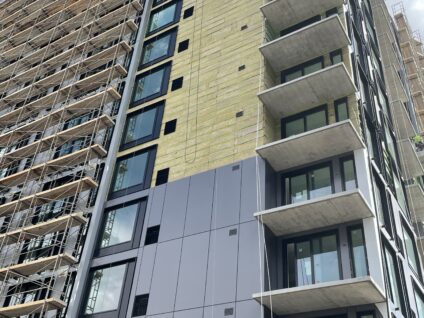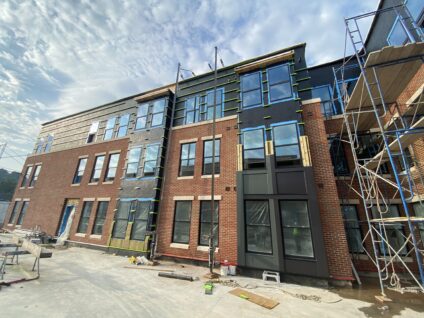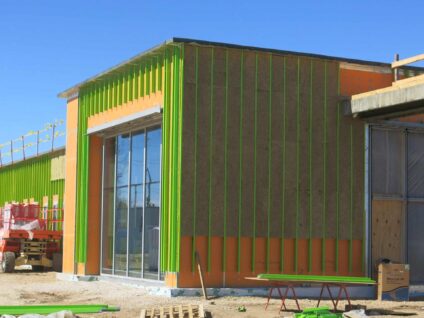I. Introduction
In modern construction, the ability of materials to endure high temperatures is more than a desired feature; it is a necessity. The selection of materials capable of withstanding prolonged exposure to elevated temperatures is pivotal for ensuring the safety, durability, and functionality of structures. From daily solar heating to exceptional circumstances such as fires, building materials must maintain their integrity to fulfill the principle that failure isn’t an option.
Service temperature is defined as the temperature range in which a material retains its desired mechanical properties. Understanding this concept is crucial in recognizing how various materials respond to prolonged high temperatures. The American Society of Heating, Refrigerating, and Air Conditioning Engineers (ASHRAE) emphasizes the importance of service temperature in their ASHRAE Handbook – Fundamentals, establishing guidelines to assess materials’ thermal properties in construction.¹
This article aims to explore the significance of service temperature in the context of construction materials, with a particular focus on their ability to withstand sustained high temperatures without losing structural integrity. By examining current research, case studies, innovations, and regulations, this article provides a comprehensive overview essential for professionals in the construction industry. Within this context, the idea that failure isn’t an option becomes a guiding principle.
II. Service Temperature: An Overview
Factors Influencing Service Temperature
Service temperature refers to the temperature range at which a material maintains its mechanical properties without significant alteration. Factors influencing this range include material composite, crystalline structure, impurity levels, and manufacturing processes. Understanding these factors is essential for predicting how a material will behave under specific temperature conditions.
- Material Composition: The chemical elements and compounds present in the material, along with their ratios, directly influence the material’s response to temperature. Specific alloys or composite materials may have enhanced thermal stability.
- Crystalline Structure: The arrangement of atoms or molecules within a solid material affects its thermal properties. Crystalline materials might exhibit different temperature behavior compared to amorphous ones, depending on the crystal lattice structure.
- Impurity Levels: Impurities, or unintended substances within the material, can modify thermal properties by disrupting the regular structure. Evan trace amounts can have significant effects on service temperature.
- Manufacturing Processes: The methods used to fabricate or process the material, such as forging, casting, or sintering, can induce changes in the microstructure, affecting its thermal behavior.
A comprehensive understanding of these factors enables engineers and scientists to predict how a material will perform under specific temperature conditions, facilitating proper selection for various industrial and construction applications. This understand also contributes to the development of materials with tailored thermal properties to meet unique performance requirements.
Standards and Methods of Measurement
The accurate determination of service temperature requires adherence to standards and testing methodologies. These practices ensure that materials are carefully evaluated for their ability to maintain mechanical properties within specific temperature ranges.
- General Approaches: Various methods are utilized to measure service temperature, including tension tests, compression tests, and thermal analysis techniques. The selection of the appropriate method depends on the material and its intended application.
- Metallic Materials Considerations: For metallic materials, specialized test methods, such as ASTM E21 – Standard Test Methods for Elevated Temperature Tension Tests of Metallic Materials, address the unique characteristics of metals at elevated temperatures. These methods guide the industry in evaluating how metals behave under specific thermal conditions.²
- Application Across Materials: The principles of service temperature measurement apply broadly across different material types, each with specialized standards and test methods tailored to the material’s properties.
- Importance in Construction: Accurate measurement of service temperature is vital in determining the suitability of materials for applications where high-temperature endurance is necessary, especially in construction where failure isn’t an option.
The Interplay with Building Design
Understanding service temperature is not just about material selection but also plays a significant role in overall building design. Considerations must include the geographical location, the building’s intended use, local climate conditions, and compliance with building codes and regulations.
Service temperature is a nuanced and critical concept in material science and construction. It necessitates rigorous testing standards to ensure materials are suitable for their intended applications, particularly when failure is not an option.
III. Building Materials’ High-Temperature Performance
Common Materials and Their Temperature Tolerances
Understanding the temperature tolerance of various building materials is fundamental in ensuring their performance under elevated temperatures.
- Metals: Metals such as steel, aluminum, and copper each have distinct temperature tolerances, which determine their suitability for various applications.
- Composites and Polymers: These materials often have lower temperature tolerances than metals but can be engineered to meet specific requirements.
- Insulation Materials: Various insulation materials have unique temperature tolerances, which are critical for their effective performance.³
Effects of Prolonged High-Temperature Exposure
The prolonged exposure of materials to high temperatures can lead to various detrimental effects:
- Thermal Fatigue: Repeated temperature cycling can cause materials to weaken over time.
- Thermal Expansion and Contraction: Different materials expand and contract at different rates, which can lead to stresses and potential failure.
- Degradation: Prolonged high temperatures can cause some materials to degrade, lose strength, or become more brittle.
- Energy Consumption: Understanding the thermal behavior of materials is essential for energy management in buildings.⁴
IV. Successful Implementations of High-Temperature Resistant Materials
Contrastingly, the proper selection and implementation of materials that resist high temperatures have led to remarkable successes across various industries.
- Thermal Efficiency in Industry: Industrial applications that require building materials to function in extreme temperatures have seen success with specifically engineered materials.
- GreenGirt® CMH™ Z-girts in Building Envelope Design – Incorporating GreenGirt CMH (composite metal hybrid) Z-girts in the building envelope continuous insulation or building envelope design promotes increased thermal efficiency in commercial structures. Within a building envelope, the temperature can be significantly higher than the outside environment, especially in areas exposed to direct sunlight and highly conductive cladding material (such as metal panels) is utilized. This process is called heat transfer, which can occur through several mechanisms, including conduction, convection, and radiation. CMH sub-framing contributes to retaining structural integrity in high temperatures while also providing a barrier and eliminating thermal bridging.
- Nickel-Aluminide Coatings in Industrial Furnace Components – By employing nickel-aluminide coatings in the components of industrial furnaces, manufacturers have successfully resisted high-temperature wear and corrosion. This application extends the lifespan of the equipment, reducing downtime and maintenance costs.
- Innovative Engineering Solutions: Successful examples of innovative solutions using high temperature-resistant materials can be found in various sections, including aerospace and automotive industries.
- Automotive Industry – Hybrid Metal-Composite in Brake Systems – The hybrid materials ability to combine the strength and heat conductivity of metals with the light weight properties of composite enables superior temperature resilience and weight reduction in brake discs and other brake system components. By optimizing heat dissipation and maintaining performance under intense thermal conditions, the hybrid material contributes to enhanced safety, efficiency, and overall vehicle performance.
- Aerospace Industry – Nickel-Based Superalloys in Jet Engines – These superalloys can withstand extreme temperatures and stresses without losing mechanical properties, making them indispensable in turbine blades and other critical engine parts. Their use has allowed for more efficient and reliable engine performance, contributing to advances in aircraft technology.
V. Innovations in Materials and Technologies
The importance of heat-resistant composites and alloys has grown substantially in various industries. These materials offer critical benefits in environments where high temperatures are common, maintaining their properties and integrity.
- Composites:
- Fiber-Reinforced Polymers (FRPs): FRPs are primarily recognized for their lightweight and strength-to-weight ratio. While they have been used in various applications, it’s worth noting that traditional FRPs are generally not designed for high-service temperature environments. Research is ongoing to explore specific fiber and resin combinations that might enhance thermal stability. However, their current utilization in high-temperature scenarios is limited, and careful consideration of their temperature tolerances is essential when selecting them for particular applications. ⁵
- Ceramic Matrix Composites (CMCs): CMCs are engineered composites that consist of ceramic fibers embedded in a ceramic matrix. Unlike conventional ceramics, these composites offer enhanced toughness, fracture resistance, and flexibility. Most notably, CMCs are renowned for their ability to withstand extremely high temperatures without substantial degradation in structural integrity.
- Composite Metal Hybrid (CMH™): CMH combines the advantages of metals and composites, offering improved heat resistance and structural integrity. These hybrids are suitable for diverse applications where both strength and temperature resilience are required and failure isn’t an option.
- Alloys:
- Nickel-Based Alloys: Known for their high-temperature stability, these alloys are utilized in demanding applications.
- Cobalt and Titanium Alloys: These materials offer a balance between strength and temperature resistance, suitable for various high-temperature applications.
VI. Regulatory Framework and Building Codes
Existing Regulations on High-Temperature Resilience
The importance of building materials’ ability to withstand high temperatures is well-recognized within the regulatory landscape. Existing building codes and standards dictate specific requirements for materials to ensure safety, durability, and performance under extreme temperature conditions.
- International Building Code (IBC): These widely adopted codes provide comprehensive guidance on materials and their appropriate use, including provision for high-temperature resilience.
- Local Regulations: Different jurisdictions may have additional or unique requirements reflecting local climate and environmental factors.
- Energy Efficiency Considerations: Regulations that focus on energy efficiency often encompass aspects of thermal performance, thereby influencing material selection and design.
Prospects for Regulatory Changes
The regulatory framework governing the service temperature of building materials is continuously evolving, reflecting technological advances, scientific understanding, and societal needs. High-temperature resilience is becoming an area of increased focus. The following aspects illustrate potential future changes:
- Integration of new Materials: The development of materials like GreenGirt CMH (composite metal hybrid) and other advanced composites with specialized service temperature ranges requires regulations to adapt. This adaptation ensures that these materials’ specific properties are considered, including their behavior at various temperature extremes.
- Sustainability and Climate Change Considerations: With a growing emphasis on sustainability and climate change adoption, regulatory requirements may shift to include broader considerations of temperature effects. These changes might include specific guidelines on service temperature to ensure long-term performance and resilience in changing environmental conditions.
- Standards for High-Temperature Performance: As our understanding of materials’ behavior at high temperatures grows, future regulations may incorporate more precise standards for service temperature. These standards could encompass not only resistance to extreme temperatures but also the effects of prolonged exposure to temperatures within and outside a material’s optimal service range.
- Harmonization with International Guidelines: Global trends in material science and building technology might drive regulatory convergence. This alignment may include shared standards for service temperature, ensuring that materials used in construction meet consistent, internationally recognized criteria for temperature resilience.
This future direction in regulation reflect a complex interplay between technological innovation, environmental stewardship, and the need to ensure that building materials are fit for purpose across a wide range of temperature conditions. By staying abreast of these trends, industry professionals can anticipate and contribute to the evolving regulatory landscape, promoting compliance and innovation in service temperature resilience.
VII. Conclusion
In conclusion, high-temperature endurance is a critical factor to consider when selecting building materials for structures exposure to elevated temperatures. Understanding the factors influencing service temperature, the performance of common materials under high temperatures, and the potential failures and successes is essential for designing resilient and durable structures.
Continuous research and innovation in heat-resistant materials and technologies are necessary to improve the performance and longevity of building materials under high-temperature conditions. It is crucial to stay updated with the latest advancements and regulatory changes to ensure the safety and resilience of structures in the face of heat-related challenges.
There are several key recommendations and future considerations to address the challenges and opportunities related to high-temperature endurance in building materials including:
- Staying up to date with the latest building codes and regulations is essential. Regularly reviewing and revising existing regulations will ensure they address emerging challenges and incorporate new technologies and materials. Additionally, implementing rigorous testing and certification processes will guarantee that building materials meet the required standards for high-temperature endurance.
- Education and training programs for architects, engineers, and construction professionals should be provided to enhance their understanding of high-temperature endurance and the selection of appropriate materials. By improving knowledge in this area, better decision-making can be achieved during the design and construction phases.
- Promoting the use of sustainable and environmentally-friendly high temperature-resistant materials is another important recommendation. By encouraging the development and adoption of such materials, the environmental impact can be reduced, and energy efficiency can be enhanced.
- Incorporating resilient design principles is essential. Structures should be designed to withstand and recover from high-temperature events. Factors such as compartmentalization, redundancy, and passive fire protection measures should be considered.
If you are interested in learning more about GreenGirt® CMH continuous insulation or SMARTci building enclosure systems, please visit our website or contact us today!
© 2023 Advanced Architectural Products
Sources:
¹ ASHRAE Handbook—Fundamentals (American Society of Heating, Refrigerating, and Air-Conditioning Engineers)
² ASTM E21-20 – Standard Test Methods for Elevated Temperature Tension Tests of Metallic Materials – https://www.astm.org/standards/e21
³ Touloukian, Y.S., et al., “Thermophysical Properties of Matter,” IFI/Plenum, 1970.
⁴ Turner, W.C., et al., “Energy Management Handbook,” 8th Edition, Fairmont Press, 2013.
⁵ A2P2001: Designing with Composite Sub-Framing for Fastener Performance and Building Envelope Service Temperature – https://greengirt.com/a2p2001-designing-with-composite-sub-framing-for-fastener-performance-and-building-envelope-service-temperature/















